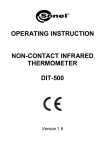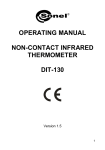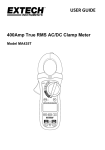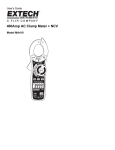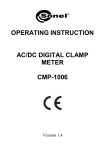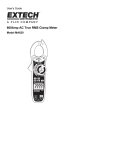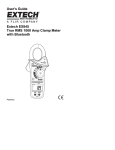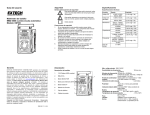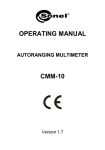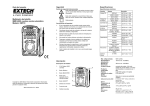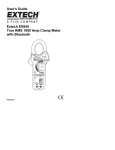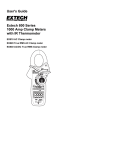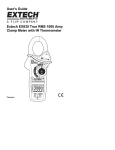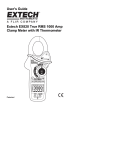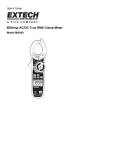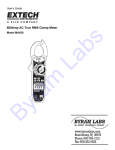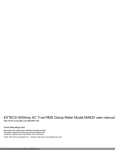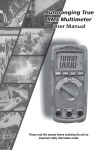Download User Manuals
Transcript
OPERATING MANUAL AC/DC CLAMP METER CMP-401 Version 1.6 The CMP-401 digital clamp meter has been designed for the purpose of clamp measurements of alternative and direct current. Furthermore, the meter may be used to measure direct and alternative voltages, resistance, frequency, temperature and to test diodes. Main features of the CMP-401 device are the following: • • • • • • • • 2 automatic or manual regulation of the measurement range, DATA HOLD function, which facilitates readings of measurements in the case of insufficient lighting or in inaccessible places, REL function, which allows you to make measurements relative to a stored reference value, the function of automatic switching of the meter into the standby mode in order to prolong the durability of batteries, circuit continuity sound signalling (Beeper), 3 ¾ digits display, safe, protected clamp jaws, double molded housing. 1 INTRODUCTION ................................................... 5 2 SAFETY ................................................................... 6 2.1 3 INTERNATIONAL SAFETY SYMBOLS ...........................................8 PREPARATION OF THE METER FOR OPERATION ........................................................... 8 4 FUNCTIONAL DESCRIPTION............................ 9 4.1 MEASUREMENT SOCKETS AND ELEMENTS OF SELECTION OF THE MEASUREMENT FUNCTION ..........................................................9 4.1.1 Sockets ..............................................................................10 4.1.2 Elements of selection of the measurement function ...........10 4.2 LCD DISPLAY ...........................................................................11 4.3 TEST LEADS ..............................................................................12 5 MEASUREMENTS ............................................... 12 5.1 5.2 5.3 5.4 5.5 5.6 5.7 5.8 5.9 6 AC AND DC CURRENT MEASUREMENTS ...................................12 AC AND DC VOLTAGE MEASUREMENTS ...................................13 RESISTANCE MEASUREMENTS ..................................................14 CONTINUITY MEASUREMENTS .................................................15 DIODE MEASUREMENTS ...........................................................15 CAPACITANCE MEASUREMENTS ...............................................16 FREQUENCY OR % DUTY CYCLE MEASUREMENTS ....................17 TEMPERATURE MEASUREMENTS ..............................................17 NON-CONTACT AC VOLTAGE MEASUREMENTS ......................18 SPECIAL FUNCTIONS ....................................... 19 6.1 6.2 6.3 6.4 MANUAL RANGE SELECTION ....................................................19 RELATIVE MODE.......................................................................19 DATA HOLD FUNCTION AND BACKLIGHT DISPLAY ...............20 MODE BUTTON .......................................................................20 7 BEFORE YOU SEND THE METER TO BE SERVICED ............................................................. 20 8 REPLACEMENT OF THE BATTERIES .......... 21 9 CLEANING AND MAINTENANCE .................. 22 10 STORAGE ............................................................. 22 3 11 DISMANTLING AND UTILIZATION .............. 22 12 ATTACHMENTS .................................................. 23 12.1 TECHNICAL DATA .....................................................................23 12.2 STANDARD EQUIPMENT ............................................................26 12.3 MANUFACTURER ......................................................................27 4 1 Introduction We appreciate your having purchased our digital clamp meter. The CMP-401 meter is a modern, high-quality measuring device, which is easy and safe to use. Please acquaint yourself with the present manual in order to avoid measuring errors and prevent possible problems related to operation of the meter. In the present manual we apply three kinds of warnings. These are texts in frames, which describe possible dangers both for the user and the meter itself. The messages starting from the word ‘WARNING:’ describe situations which imply a risk for life or health should the recommendations presented in the present manual not be observed. The word ‘ATTENTION!’ introduces a description of a situation where non-observance of the recommendations presented in the present manual may imply damage for the meter. Indications of possible problems are preceded by the word ‘Attention:’. WARNING: Before using the instrument acquaint yourself with the present manual and observe the safety regulations and recommendations specified by the manufacturer. WARNING: The purpose of the CMP-401 meter is to realise measurements of the current, directs and alternative voltages, resistance, frequency, temperature and diode testing. Using the meter in a manner which does not comply with the recommendations specified in the present manual may lead to its damage and constitutes a source of a serious risk for the user. 5 WARNING: The CMP-401 meter may be operated solely by qualified and properly authorised personnel for work at electric installations. Using the meter by unauthorised personnel may lead to its damage and constitutes a source of a serious risk for the user. 2 Safety In order to guarantee proper operation and correctness of the obtained results it is necessary to observe the following recommendations: • Before commencing operation of the meter please acquaint yourself thoroughly with the present manual, • The instrument should be operated solely by properly qualified personnel, who also must be trained regarding the industrial safety regulations, • Use great care when making measurements if the voltages are greater than 25V AC rms or 35V DC. These voltages are considered a shock hazard, • Before use for non-contact AC voltage measurements, always test the voltage detector on a known live circuit to verify proper operation, • Set function switch to the appropriate position before measuring, • When measuring volts do not switch to current/resistance modes, • Do not exceed the maximum allowable input range of any function, • Do not apply voltage to meter when resistance function is selected, • When changing ranges using the selector switch always disconnect the test leads from the circuit under test, • Do not exceed the maximum rated input limits, • It is prohibited to operated the meter: 6 • ⇒ If it is damaged and completely or partially out of order ⇒ If the insulation of the test leads has been damaged ⇒ If it has been stored for an excessive period of time in inadequate conditions (e.g. if it is humid) Repairs must be realised solely by an authorised service workshop WARNING: Do not realise measurements with wet hands. WARNING: Do not realise measurements in environments in which there are inflammable gases. Otherwise operation of the meter under such conditions may cause sparking and explosion. ATTENTION! Input Limits Function A AC V DC, V AC Frequency, Resistance, Diode, Continuity , Temperature (°C/°F) Maximum Input 400A 600V DC/AC 250V DC/AC 250V DC/ AC 7 2.1 International Safety Symbols This symbol, adjacent to another symbol or terminal, indicates the user must refer to the manual for further information. This symbol, adjacent to a terminal, indicates that, under normal use, hazardous voltages may be present Double insulation 3 Preparation of the meter for operation Having purchased the meter examine completeness of the contents of the package. Before measurements commence, it is necessary to realise the following actions: • Make sure the conditions of the batteries or accumulators permit to realise measurements, • Make sure the casing of the meter and the insulation of the test leads are not damaged. WARNING: Connection of inappropriate or damaged test leads constitutes a risk of an electric shock with a dangerous voltage. 8 4 Functional description 4.1 Measurement sockets and elements of selection of the measurement function Ω Illustration 1. CMP-401 9 4.1.1 Sockets 11 12 measurement socket V/Ω/CAP/TEMP Measurement socket for the purpose of measurements of direct and alternative voltages resistance, capacity, frequency and temperature. measurement socket COM Measurement socket common for all the measurement functions except of current measurements (connection to the mass of the device). 4.1.2 Elements of selection of the measurement function 1 current clamp 2 non-contact AC voltage indicator light 3 clamp trigger 4 rotational selector Selection of function: • OFF – meter off, • V – direct and alternative voltage measurement, • Ω CAP – resistance, capacitance and continuity measurement and diode testing, • °C °F – Fahrenheit and Celsius temperature measurement, • 40A – direct current measurement up to 40A, • 400A – direct current measurement up to 400A, • 40A~ – alternative current measurement up to 40A, • 400A~ – alternative current measurement up to 400A. 5 HOLD button • Data Hold function, • Back Light function. 6 REL button • Relative measurement function, • Exit of relative measurement function, • 10 DCA zero. 7 8 LCD display MODE button • Changing of measurement mode 9 RANGE button • Manual range selection 10 Hz/% button • Frequency/duty cycle selection 13 battery cover 4.2 LCD display Illustration 2. LCD display of the CMP-401 meter – minus sign AC, DC – AC (alternating current) and DC (direct currrent) AUTO – AutoRange mode – diode test mode – continuity check mode HOLD – Data Hold mode ZERO – Relative Measurement mode 11 Hz % – frequency/duty cycle test mode k, M, Ω, n, µ, F, m, V, °C, °F, A – units of measure list + _ _ – low battery indication BAT – low battery indication (change battery) 4.3 Test leads The manufacturer guarantees correct measurement indications provided original test leads are used. WARNING: Connection of inadequate test leads constitutes a risk of electric shock with a dangerous voltage or may be a cause of measurement errors. 5 Measurements It is recommended to get acquainted thoroughly with the contents of the present chapter since it describes the measurement systems, the manner of realisation of measurements and the basic principles of interpretation of the results. 5.1 AC and DC current measurements WARNING: Do not take current readings on circuits where the maximum current potential is not known. Do not exceed the maximum allowable input range while measuring current. 12 WARNING: Do not realise measurements if the battery compartment is open. WARNING: Do not commence current measurements if the test leads are connected to the meter. In order to realise a measurement of alternative current, it is necessary to realise the following actions: • Set the Function switch to the 40A or 400A or 40A~ or 400A~, if the range of the measured is not known, select the highest range first, • press the REL button to zero the meter (in DC mode), • open the clamp and place it on a single cable, • read the result of the measurement on the display, • move to the lower range if necessary. Attention: During measurements of the current make sure the clamp is properly placed. Otherwise the results of the measurements will not be exact. The most exact result we will get if the wire is placed in the middle of clamp. 5.2 AC and DC voltage measurements In order to realise a measurement of AC or DC voltage, it is necessary to realise the following actions: • set the function switch to the V position, • select AC or DC with the MODE button, • with the RANGE button set the measurement range manually if necessary, 13 • connect the red test lead to socket V/Ω/CAP/TEMP and the black one to socket COM, place the edges of the probes to the measurement points; while measuring DC voltage place the red probe to the point of higher potential, read the result of the measurement on the display, having done the measurement disconnect the test leads from the meter. • • • 5.3 Resistance measurements WARNING: Measurements must not be realised in live circuits. Capacitors must be discharged. WARNING: Do not realise measurements if the battery compartment is open. In order to realise a measurement of the resistance it is necessary to realise the following actions: • place the rotational selector in the position Ω CAP, • connect the red test lead to sockets V/Ω/CAP/TEMP and the black one to sockets COM, • make sure symbol is displayed with open test leads, and in the case of shorted terminals of the measurement probes the display shows „0”, • with the RANGE button set the measurement range manually if necessary, • touch the test probe tips across the circuit or component under test; it is best to disconnect one side of the device under test so the rest of the circuit will not interfere with the resistance reading, • read the result of the measurement on the display, 14 • having done the measurement disconnect the test leads from the meter. 5.4 Continuity Measurements WARNING: Measurements must not be realised in live circuits. Capacitors must be discharged. WARNING: Do not realise measurements if the battery compartment is open. In order to realise continuity test it is necessary to realise the following actions: • place the rotational selector in the position Ω CAP, • connect the red test lead to sockets V/Ω/CAP/TEMP and the black one to sockets COM, • press the MODE button until appears in the display, • make sure symbol is displayed with open test leads, and in the case of shorted terminals of the measurement probes the display shows „0”, • touch the test probe tips to the circuit under test, • read the result of the measurement on the display; if the resistance is < 50Ω, a tone will sound, • having done the test disconnect the test leads from the meter. 5.5 Diode Measurements WARNING: Measurements must not be realised in live circuits. Capacitors must be discharged. 15 WARNING: Do not realise measurements if the battery compartment is open. In order to realise continuity test it is necessary to realise the following actions: CAP, • place the rotational selector in the position Ω • connect the red test lead to sockets V/Ω/CAP/TEMP and the black one to sockets COM, • press the MODE button until appears on the display, • touch the test probes to the diode under test - forward voltage will indicate 0,4V to 0,7V, reverse voltage will indicate “OL”; shorted devices will indicate near 0mV and an open device will indicate “OL” in both polarities, • having done the test disconnect the test leads from the meter. 5.6 Capacitance measurements WARNING: Measurements must not be realised in live circuits. Capacitors must be discharged. WARNING: Do not realise measurements if the battery compartment is open. In order to realise capacitance test it is necessary to realise the following actions: • place the rotational selector in the position Ω CAP, • connect the red test lead to sockets V/Ω/CAP/TEMP and the black one to sockets COM, • press the MODE button until F appears on the display, 16 • • • touch the test leads to the capacitor to be tested, read the capacitance value in the display, having done the measurement disconnect the test leads from the meter. 5.7 Frequency or % duty cycle measurements WARNING: Do not realise measurements if the battery compartment is open. In order to realise frequency or % duty cycle measurement it is necessary to realise the following actions: • place the rotational selector in the position V , • connect the red test lead to sockets V/Ω/CAP/TEMP and the black one to sockets COM, • select Hz or % duty with the Hz/% button, • touch the test probe tips to the circuit under test, • read the frequency on the display, • having done the measurement disconnect the test leads from the meter. 5.8 Temperature measurements WARNING: Do not realise measurements if the battery compartment is open. WARNING: To avoid electric shock, disconnect both test probes from any source of voltage before making a temperature measurement. 17 WARNING: To avoid electric shock, be sure the thermocouple has been removed before changing to another measurement function. In order to realise temperature measurement it is necessary to realise the following actions: • • • place the rotational selector in the position °C °F, press the MODE button to select °C or °F, insert the temperature probe into the negative COM and the V/Ω/TEMP terminals, making sure to observe the correct polarity, touch the temperature probe head to the part whose temperature you wish to measure, keep the probe touching the part under test until the reading stabilizes (about 30 seconds), read the temperature in the display, the digital reading will indicate the proper decimal point and value, having done the measurement disconnect the test leads from the meter. • • • 5.9 Non-Contact AC Voltage Measurements WARNING: Risk of Electrocution. Before use, always test the voltage detector on a known live circuit to verify proper operation. In order to realise the test it is necessary to realise the following actions: • • 18 touch the current clamp to the live conductor or insert into the live side of the electrical outlet, if AC voltage is present, the detector light will illuminate. Note: The conductors in electrical cord sets are often twisted. For best results, rub the probe tip along a length of the cord to assure placing the tip in close proximity to the live conductor. Note: The detector is designed with high sensitivity. Static electricity or other sources of energy may randomly trip the sensor. This is normal operation. 6 Special functions 6.1 Manual range selection When the meter is first turned on, it automatically goes into AutoRanging. This automatically selects the best range for the measurements being made and is generally the best mode for most measurements. For measurement situations requiring that a range be manually selected, perform the following: • • • 6.2 press the RANGE button - the “Auto Range” display indicator will turn off, press the RANGE button to step through the available ranges until you select the range you want, press and hold the RANGE button for 2 seconds to exit the ManualRanging mode and return to AutoRanging. Relative mode Press REL button to enter the relative mode, the REL indicator turns on,, zero the display, and stores the displayed reading as a reference value. 19 In the relative mode, the value shown on the LCD is always the difference between the stored reference value and the present reading. For example, if the reference value is 24,00V and the present reading is 12,50V, the display will indicate -11,50V. If the new reading is the same as the reference value, the display will be zero. This feature also is made as DCA ZERO adjustment. Press the REL button again to exit the relative mode. 6.3 DATA HOLD Function and Backlight display To freeze the LCD meter reading, press the HOLD button. The data hold button is located on the left side of the meter (top button). While data hold is active, the HOLD display icon appears on the LCD. Press the data hold button again to return to normal operation. Press and hold the HOLD button key for more than 2 seconds to turn on the backlight. This will also activate the Data Hold function. To release the Data Hold function and return the tester to normal operation, press the HOLD button momentarily. To turn off the backlight, press and hold the HOLD button for more than 2 seconds. 6.4 MODE button The MODE button is used for DC/ACV or OHM/Diode/Continuity/Capacitance or °C/°F selection. 7 Before you send the meter to be serviced Before sending the instrument to be repaired call the workshop, since it is possible the meter is not damaged, and the problem has occurred for some other reason. Elimination of damage to the meter must be realised solely in workshops authorised by the manufacturer. 20 The following table presents recommendations regarding proceeding in certain situations which may occur during operation of the meter. DESCRIPTION REASON The meter does not Low batteries. turn on. Unintelligible and randomly displayed segments of the LCD display. Erroneous measLack of acclimatiurement after movsation. ing the meter from a cold environment to a warm place of high humidity. The test lead is damaged. The test lead is broken or torn off the terminal. SOLUTION Replace the batteries. If the situation does not change send the meter for repair. Do not perform measurements until the meter has reached the temperature of the environment (approximately 30 minutes). Replace the test lead. 8 Replacement of the batteries The CMP-400 meter is supplied by means of one 9V battery. It is recommended to use alkaline battery. Attention: When making measurements with a battery's mnemonic on, one must take into account additional indefinite measurement uncertainty or unstable working of the meter. 21 WARNING: Should the test leads be left in the sockets during replacement of the battery, there might be a risk of electric shock with a dangerous voltage. In order to replace the battery it is necessary to do the following: • remove all the test leads from the measurement sockets and place rotational selector in the position OFF, • remove the one rear Phillips head screw, • open the battery compartment, • replace the required one 9V battery, • re-assemble the meter. 9 Cleaning and maintenance The casing of the meter may be cleaned with a soft, damp cloth using all-purpose detergents. Do not use any solvents or cleaning agents which might scratch the casing (powders, pastes, etc.). The electronic system of the meter does not require maintenance. 10 Storage In the case of storage of the device, the following recommendations must be observed: • Disconnect all the test leads from the meter, • Make sure the meter and its accessories are dry, • In the case the meter is to be stored for a prolonged period of time, the battery must be removed from the device. 11 Dismantling and utilization Worn-out electric and electronic equipment should be gathered selectively, i.e. it must not be placed with waste of another kind. 22 Worn-out electronic equipment should be sent to a collection point in accordance with the law of worn-out electric and electronic equipment. Before the equipment is sent to a collection point, do not dismantle any elements. Observe the local regulations concerning disposal of packages, worn-out batteries and accumulators. 12 Attachments 12.1 Technical data • “m.v.” means measured value of standard. AC current measurement Range Resolution 40,00A 0,01A 400,0A 0,1A • frequency range 50...60Hz DC current measurement Range Resolution 40,00A 0,01A 400,0A 0,1A AC voltage measurement Range Resolution 400,0mV 0,1mV 4,000V 0,001V 40,00V 0,01V 400,0V 0,1V 600V 1V • frequency range 50...400Hz Basic uncertainty ± (2,5% m.v. + 8 digits) ± (2,8% m.v. + 5 digits) Basic uncertainty ± (2,5% m.v. + 5 digits) ± (2,8% m.v. + 5 digits) Basic uncertainty ± (1,5% m.v. + 30 digits) ± (1,5% m.v. + 5 digits) ± (2% m.v. + 5 digits) 23 DC voltage measurement Range Resolution 400,0mV 0,1mV 4,000V 0,001V 40,00V 0,01V 400,0V 0,1V 600V 1V Resistance measurement Range Resolution 400,0Ω 0,1Ω 4,000kΩ 0,001kΩ 40,00kΩ 0,01kΩ 400,0kΩ 0,1kΩ 4,000MΩ 0,001MΩ 40,00MΩ 0,01MΩ Basic uncertainty ± (0,8% m.v. + 2 digits) ± (1,5% m.v. + 2 digits) ± (2% m.v. + 2 digits) Basic uncertainty ± (1 % m.v. + 4 digits) ± (1,5 % m.v. + 2 digits) ± (2,5 % m.v. + 3 digits) ± (3,5 % m.v. + 5 digits) Frequency measurement Range Basic uncertainty 10Hz...10kHz ± (1,5 % m.v. + 2 digits) • sensitivity: 100V (<50Hz), 50V (50…400Hz); 15V (401Hz… 10kHz) Duty Cycle Range & Resolution Basic Accuracy 10.0…94.9% unspecificated Pulse width: 100µs…100ms, Frequency: 30Hz…15kHz; Sensitivity: 30…5kHz:10Vrms min. 5kHz…15kHz:40Vrms min. 24 Capacitance measurement Range Resolution 40,00nF 0,01nF 400,0nF 0,1nF 4,000µF 0,001µF 40,00µF 0,01µF 100,0µF 0,1µF Temperature measurement Range -20.0…760,0°C Basic uncertainty ± (4 % m.v. + 20 digits) ± (3 % m.v. + 5 digits) ± (4 % m.v. + 10 digits) Basic uncertainty * ± (3% m.v. + 5°C) -4.0…1400°F ± (3% m.v. + 9°F) * probe (K type) accuracy not included Other technical data a) Measurement category in acc. with EN 61010-1 .............III 600V b) Ingress protection in acc. with EN 60529 ............................ IP40 c) Pollution degree........................................................................ 2 d) Power supply ....................................................... one 9V battery e) Clamp size.....................................Opening 30mm (1,2") approx f) Diode test ................................................ I=0,3mA, U0=1,5V DC g) Continuity test ......................... I<0,5mA, sound signal for R<50Ω h) Overrange indication.............................................. OL displayed i) Measurements rate.................................. 2 per second, nominal j) Input impedance .............................................. 10MΩ (V AC/DC) k) Display ...........................................................LCD, 4000 counts l) Dimensions..................................................... 197 x 70 x 40 mm m) Weigh ................................................................................ 183 g n) Operating temperature........................... 5 to 40°C (41 to 104°F) o) Storage temperature ............................ -20 to 60°C (-4 to 140°F) p) Operating humidity ......... max 80% up to 31°C (87°F) decreasing ........................................................ linearly to 50% at 40°C (104°F) q) Storage humidity................................................................<80% r) Max. operating altitude .............................. 2000meters (7000ft.) s) Auto OFF ...................................................... approx. 30 minutes 25 t) Compliance with the requirements specified in the following norms ...................................................................... EN 61010-1 ............................................................................... EN 61010-2-032 u) Quality standard .......................................................... ISO 9001 12.2 Standard equipment The standard set provided by the manufacturer includes the following components: • The CMP-401 meter, • Test leads (2 pieces), • 9V battery, • K-Type temperature probe, • Carrying case, • Operating manual, • Guarantee card. 26 12.3 Manufacturer The manufacturer of the device, which also provides guarantee and post-guarantee service is the following company: SONEL S. A. ul. Wokulskiego 11 58-100 Świdnica Tel: +48 74 858 38 60 Fax: +48 74 858 38 09 E-mail: [email protected] Web page: www.sonel.pl Note: Service repairs must be realised solely by the manufacturer. Made in China for SONEL S.A. 27



























